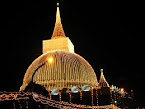The Buddha’s dispensation is founded upon three guiding ideals or objects of veneration: the Buddha, the Dhamma and the Sangha. The Buddha is the teacher, the Dhamma is the teaching and the Sangha is the community of those who have realized the teaching and embody it in their lives. These three are together called the Three Jewels or Triple Gem. They are called the Three Jewels because for one who is seeking the way to liberation, they are the most precious things in the World.
The word ‘Sangha’ means those who are joined together, thus a Community. However, "Sangha" does not refer to the entire Buddhist Community, but to the two kinds of Communities within the larger Buddhist Society:
They are -
The Noble Sangha (Ariya Sangha).The community of the Buddha’s true disciples.
The conventional Sangha. Fully ordained monks and nuns.
In principle, the word Sangha includes bhikkhunis - that is, fully ordained nuns - but in Theravada countries the full ordination lineage for women has become defunct, though there continue to exist independent orders of nuns.
The holy life requires purified conduct but household life stimulates many desires that run contrary to pure conduct. The homeless life is a life of meditation calling for constant mindfulness, clear awareness and contemplation. All this needs time, a calm environment, freedom from external pressures and responsibility. The Buddha founded in Sangha in order to provide such objective conditions.
The bhikkhu, the Buddhist monk, is not a priest; he does not function as an intermediary between the laity and any divine power, not even between the lay person and the Buddha. He does not administer sacraments, pronounce absolution or perform any ritual needed for salvation. The main task of a bhikkhu is to cultivate himself along the path laid down by the Buddha, the path of moral discipline, concentration, and wisdom.










0 comments:
Post a Comment